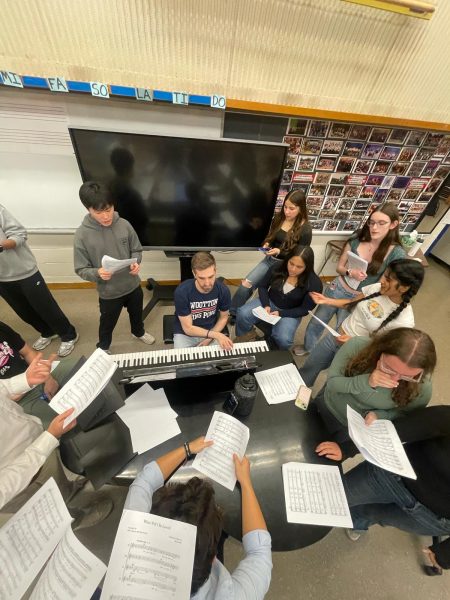Teachers’ variation in grading policies unfair to students
Sophomores Lindsey Mcney and Elsa Liljas compare a math test grade during lunch.
Warnings spread quickly from student to student and grade to grade about which teachers are easier graders than others. Students gossip about which teachers are nice and which are strict because they know that a teacher’s policies in the classroom have a massive impact on their grade.
The unfortunate reality is that grades and GPAs are important for students striving to be accepted into elite colleges. A student’s grades are often considered one of the most influential factors in college admissions decisions. This is why the substantial variation in classroom and grading policies is unfair to students.
I have experienced the variation in classroom policies and the immediate effect it can have on students’ grades first hand. A prominent example of varying policies is when certain classes have the option to take tests assisted by open notes while others taking the same test with different teachers do not get that privilege. Another is when teachers provide extra time during lunch or advisory to finish tests for students without extended time. Other students who took the same test in a class taught by a different teacher had to complete the test in one 42-minute period. Giving more time on tests allows for students to complete parts of the test they would have lost points had they left it blank in the allotted time. It also gives students the opportunity to take advantage of the time they have in between their class period and advisory to talk with students who completed the test and use online resources to research answers to the test questions they have already seen.
High school transcripts include the name of the courses taken, the grades and the GPA but do not include the name of the teachers or their grading policies. With over 2,000 students in the school, nearly every course has multiple classes taught by different teachers.
When two students take the same course but one is taught by a teacher who gives minimal tests and easy assignments, while the other is taught by a teacher with frequent and difficult assessments, colleges have no way of knowing the different level of effort needed to be put into their grades and the students are judged on the same scale. Although the student may learn more in a rigorous class, it is frustrating and unfair for students to not have to put in equal amounts of effort for an A because of the discrepancy in teacher’s grading and classroom policies.
With a school system that tells students their grade point averages and standardized test scores determine their intelligence, should A’s not mean the same level of effort and workload for every student?
Teachers are bound to have different opinions on the best methods of teaching and make different choices in their classrooms for what they believe will best help their students learn. But when the differences are so substantial that a class taught by one teacher is an “easy A” and the same class taught by another is difficult it becomes incredibly unfair to the students.
Your donation will support the student journalists of Thomas S. Wootton High School. Your contribution will allow us to purchase equipment and cover our annual website hosting costs.
Elizabeth is a 2024 graduate.







![The 2025-2026 Editorial Board Alex Grainger, Cameron Cowen, Helen Manolis, Emory Scofield, Ahmed Ibrahim, Rebekah Buchman, Marley Hoffman, Hayley Gottesman, Pragna Pothakamuri and Natalie Pak (Chase Dolan not pictured) respond to the new MCPS grading policy. “When something that used to be easy suddenly becomes harder, it can turn [students’] mindset negative, whereas making something easier usually has a better impact. I think that’s where a lot of the pushback comes from. But if you put emotions aside, I do think this change could help build stronger work ethic,” Ibrahim said.](https://woottoncommonsense.com/wp-content/uploads/2025/09/fqr5bskTXpn0LRQMmKErLuNKdQYBlL726cFXBaWF-600x450.jpg)